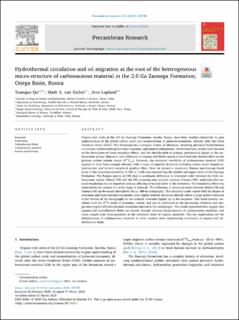| dc.contributor.author | Qu, Yuangao | |
| dc.contributor.author | Van Zuilen, Mark | |
| dc.contributor.author | Lepland, Aivo | |
| dc.date.accessioned | 2021-06-28T10:38:32Z | |
| dc.date.available | 2021-06-28T10:38:32Z | |
| dc.date.created | 2020-06-10T12:56:59Z | |
| dc.date.issued | 2020 | |
| dc.identifier.issn | 0301-9268 | |
| dc.identifier.uri | https://hdl.handle.net/11250/2761590 | |
| dc.description.abstract | Organic-rich rocks of the 2.0 Ga Zaonega Formation, Karelia, Russia, have been studied extensively to gain understanding of the global carbon cycle and reconstruction of paleo-environments, directly after the Great Oxidation Event (GOE). This formation has a complex history of alteration, involving pervasive hydrothermal circulation, hydrocarbon generation/migration, and mineral authigenesis. Several previous studies have focused on the description of these secondary effects, and the identification of primary geochemical signals in the carbonaceous phases. Migration and infiltration of organic-rich fluids appear to have had only limited effect on the primary carbon isotope record (δ13Corg). However, the structural variability of carbonaceous material (CM) appears to have been strongly affected, with a range of reported structures including carbon onion-shaped nanostructures and mineral-templated graphite films. Here we present a systematic Raman spectroscopy-based study of the structural variability of CM in a drill core representing the middle and upper strata of the Zaonega Formation. The Raman spectra of CM show a systematic difference in structural order between the bulk carbonaceous matrix (Matrix-CM) and the CM occurring near mineral contacts (Contact-CM), indicating that mineral templating was an important process affecting structural order in the formation. The templating effect was observed on the surface of a wide range of minerals. The difference in structural order between Matrix-CM and Contact-CM can be traced throughout the ca. 400 m stratigraphy. The structural order varied with the degree of alteration and hydrothermal circulation, from highly ordered structures directly above a large gabbro intrusion at the bottom of the stratigraphy to less ordered structures higher up in the sequence. This trend directly correlates with the δ18O trend of secondary calcite, and can be attributed to the decreasing influence and temperature regime of hydrothermal circulation upward in the stratigraphy. The results presented here suggest that organic-rich hydrothermal fluids can locally strongly enhance graphitization of carbonaceous materials, and cause sample-scale heterogeneities in the structural order of organic materials. This has implications for the interpretation of carbonaceous materials in other ancient rocks experiencing circulation of organic-rich hydrothermal fluids. | en_US |
| dc.language.iso | eng | en_US |
| dc.publisher | Elsevier | en_US |
| dc.rights | Navngivelse 4.0 Internasjonal | * |
| dc.rights.uri | http://creativecommons.org/licenses/by/4.0/deed.no | * |
| dc.title | Hydrothermal circulation and oil migration at the root of the heterogeneous micro-structure of carbonaceous material in the 2.0 Ga Zaonega Formation, Onega Basin, Russia | en_US |
| dc.type | Journal article | en_US |
| dc.type | Peer reviewed | en_US |
| dc.description.version | publishedVersion | en_US |
| dc.rights.holder | Copyright 2020 The Authors. | en_US |
| dc.source.articlenumber | 105705 | en_US |
| cristin.ispublished | true | |
| cristin.fulltext | original | |
| cristin.qualitycode | 2 | |
| dc.identifier.doi | 10.1016/j.precamres.2020.105705 | |
| dc.identifier.cristin | 1814783 | |
| dc.source.journal | Precambrian Research | en_US |
| dc.identifier.citation | Precambrian Research. 2020, 343, 105705. | en_US |
| dc.source.volume | 343 | en_US |

